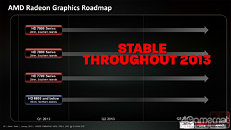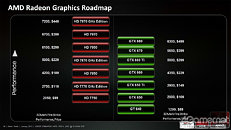Sunday, February 10th 2013

No New GPUs from AMD for the Bulk of 2013
AMD's product manager for desktop graphics products Devon Nekechuk, in an interview with Japanese publication 4Gamer.net, revealed that his firm won't be launching any new Radeon GPUs in 2013, and that the company would instead play out the year on its current Radeon HD 7000 series' performance, with price adjustments and possible performance increments through driver updates. In a slide released to 4Gamers.net, AMD pointed that its Radeon HD 7900 series (high-end), HD 7800 series (performance), and HD 7700 series (mainstream), will carry on the company's mantle "throughout 2013."
This announcement is indication that GPU makers have decided to slow things down from the streak of rapid new GPU launches that lasted from some time around 2007, running up to 2012, which can be heavily taxing in terms of R&D costs for either companies. We know for sure that NVIDIA is clearing its backlog of consumer GPU development by releasing the GeForce GTX "Titan" graphics card in a couple of weeks' time, and we know from older reports that NVIDIA could launch a "refreshed" GeForce Kepler lineup, that largely retains the GeForce Kepler silicon while topping up with subtle changes (clock speeds, software features that don't involve redesigning the silicon, etc.,) but AMD coming out in the open with this announcement could change everything. NVIDIA has the opportunity to save a few coins by sticking to its current lineup (plus the upcoming GTX "Titan,") and responding to competition from AMD by price-adjustments and timely driver optimizations of its own.
Source:
4Gamer.net
This announcement is indication that GPU makers have decided to slow things down from the streak of rapid new GPU launches that lasted from some time around 2007, running up to 2012, which can be heavily taxing in terms of R&D costs for either companies. We know for sure that NVIDIA is clearing its backlog of consumer GPU development by releasing the GeForce GTX "Titan" graphics card in a couple of weeks' time, and we know from older reports that NVIDIA could launch a "refreshed" GeForce Kepler lineup, that largely retains the GeForce Kepler silicon while topping up with subtle changes (clock speeds, software features that don't involve redesigning the silicon, etc.,) but AMD coming out in the open with this announcement could change everything. NVIDIA has the opportunity to save a few coins by sticking to its current lineup (plus the upcoming GTX "Titan,") and responding to competition from AMD by price-adjustments and timely driver optimizations of its own.



233 Comments on No New GPUs from AMD for the Bulk of 2013
;)
To me this looks like AMD is getting ready to release the 8XXX cards. This also, looks like something to get everyone that's holding off for the next gen to go ahead and buy now. If you look at the stock of nvidia cards at newegg you can see they still have a ton of cards.. AMD maybe pulling a fast one on Nvidia.. If AMD releases the 8XXX cards and they are a lot faster than nvidia's 6xx cards for the same price, then nvidia will be forced to drop the price on those cards and take a big lose.. With AMD in all of the new consoles they can afford to do this... It reminds me of the sleeping dragon quote.. ;) Only time will tell now. :toast:
15 SMX was the design the original silicon had. The one Nvidia taunted when it announced GK110. Nothing with 15 SMX has come out not K20X or K20.
Even the white paper you link alludes to that but look up specs for K20X 14 SMX and K20 13 SMX none use 15 SMX. Dont know where you get K20 uses 15 SMX if K20X doesnt.There are a few other things in the Whitepaper just like the 15 SMXs that never made it to K20X and K20.
;)
I know it because I have been studying computer architecture and processor design as in HW for a very long time.
Do you have any idea how hard it is to manufacture a 7 billion transistor GPU which is well over 500mm2 in die area? Especially how the defect rate/yield relates to the die area? Yeah I guess you don't. You don't have to work for NVIDIA for that btw...
There is no fully enabled GK110 out and there won't be for a long time. Why? Because the amount of fully working chips from these pre-launch risk wafers is too low to launch a product with mass availability without making unacceptable trade of amount of GPUs you can sell and the cost of manufacturing them. Even GK104 and Tahiti get a lot partially defective GPUs from the Fabs just look at the amount of them being sold. And those are more than third smaller than GK110 die. As die size increases not only are you getting less chips out of the wafer in best scenario but the change there are multiple defects on a single chip goes up too and fast.
After a long period of time which is many months the yields will improve and stabilize as the manufacturing process matures for that exact product. This is especially true for gigantic ICs. At this point you'd generally start selling the stockpile of partially working ICs too because there is plenty in storage from manufacturing up to this point.
What I am in fact saying is quite the opposite you thought as my logic. Tahiti, and GK104 for that matter, are less prone to multiple defects per chip resulting in better yields.
3072 Stream Processors at a price-point under $500...
anyone else up for that???
Yes, It may come down to slowing development, resources, manpower, tied to a shrink market. IDK It could be that pulling back is related to both Volcanic Islands, and Nvidias’ Maxwell and 20Nm manufacturing. But overall AMD probably knows Nvidias' path is 8+ months out, so why not slow it down. Last time they moved early and it brought more grief on them.
Lastly this has almost nothing to do with Titian, except Nvidia (and AMD) wants to see how many they can sell, and can they elevate the market in future go arounds. Proving there might be enough takers in a $600-750 range to bump normal "enthusiast" price point fo Maxwell in 2014-2015. This will permit AMD to see if Nvidia might bring other lower derivatives from further gelding GK110’s. That could give AMD an idea if Nvidia could in fact bump the GK104 die with a slight revamp while hitting good gains? I really believe AMD priced the 7970 because they really thought Nvidia would be onboard, but they pulled a fast one on AMD by getting to work from the GK104.
This is AMD being smart... for all the right reasons. ;)
While a larger die invariably will contain more defects than a smaller one, no one here- not even you - know what the defect rate is, and more importantly, how much redundancy is built into the GPU die to allow for defects. So, while I would be agreement with you over the likelihood of a lower yield as die size increases, I am not in agreement with absolute statements that aren't supplied with corroborative proof....I'd also contend that "massive" is a relative term. I don't think the GK 110 would be appreciably larger than GF 110 - and if anyone has experience in producing large complex GPUs, it's probably Nvidia...the 20,000+ units shipped from the first A1 revision are probably testimony to that.
This thread is about discussing what AMD is going to do this year (or not do, lol).
Carry on. :toast:
The other thing is i don't see the point of new GC's either from AMD or Nvidia not until we see screens/monitors getting mainstream with higher resolution then 1080 , no really don't we have this resolution for long enough already? (for PC)
Sony CEO Kazuo Hirai - "Why go first, when your competitors can look at your specifications and come up with something better?” :peace:
Week later, Sony show's off a teaser trailer of the most likely PS4 announcement Feb 20th trolling Microsoft & surprising everyone :)